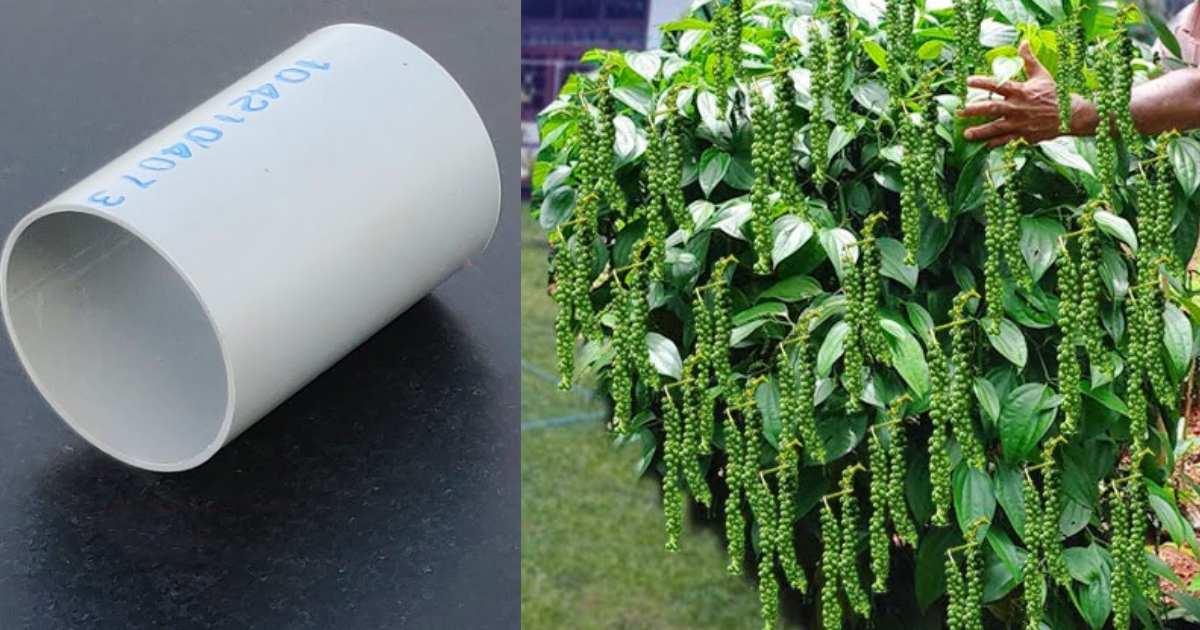
വീട്ടിൽ ഒരു കഷ്ണം PVC പൈപ്പ് ഉണ്ടോ.!! ഇനി കുരുമുളക് പറിച്ച് മടുക്കും; ഒരു ചെറിയ കുരുമുളകിൽ നിന്നും കിലോ കണക്കിന് പറിക്കാം.!! Pepper Cultivation using PVC Pipe
Pepper Cultivation using PVC Pipe : നമ്മുടെയെല്ലാം വീടുകളിൽ കറികളിൽ സ്ഥിരമായി ഉപയോഗിക്കാറുള്ള ഒരു സുഗന്ധവ്യഞ്ജനം ആണല്ലോ കുരുമുളക്. സാധാരണയായി കുരുമുളക് പടർത്തി വിട്ട് കഴിഞ്ഞാൽ അതിൽ നിന്നും കുരുമുളക് ലഭിക്കുക എന്നത് എളുപ്പമുള്ള കാര്യമല്ല. മാത്രമല്ല അതിനായി ധാരാളം സ്ഥലത്തിന്റെയും മരങ്ങളുടെ ആവശ്യവുമെല്ലാം കൂടുതലാണ്. എന്നാൽ എത്ര സ്ഥലപരിമിതി ഉള്ള സ്ഥലത്തും വീട്ടാവശ്യങ്ങൾക്കുള്ള കുരുമുളക് വളരെ
എളുപ്പത്തിൽ പടർത്തിയെടുക്കാനായി സാധിക്കും. അത് എങ്ങനെയാണെന്ന് വിശദമായി മനസ്സിലാക്കാം. വീടിന്റെ മുറ്റത്തൊട് ചേർന്നുള്ള ഏതെങ്കിലും ഒരു സ്ഥലം തിരഞ്ഞെടുത്ത് ഈയൊരു രീതിയിൽ കുരുമുളക് വളർത്തിയെടുക്കാവുന്നതാണ്. അതിനായി മണ്ണിൽ അത്യാവശ്യം വട്ടമുള്ള ഒരു പിവിസി പൈപ്പ് നാട്ടുകയാണ് വേണ്ടത്. അത് മണ്ണിലേക്ക് കുഴിഞ്ഞു നിൽക്കുന്ന രീതിയിലാണ് വേണ്ടത്. അതിന് അകത്തു കൂടെ വളർന്നു വരുന്ന രീതിയിലാണ് ചെടി നട്ടു പിടിപ്പിക്കേണ്ടത്.
ഈ ഒരു രീതിയിൽ ചെടി നട്ട് വളർത്തുകയാണെങ്കിൽ പടർന്ന് പന്തലിച്ചു പോകുന്ന പ്രശ്നം വരുന്നില്ല. മാത്രമല്ല ഒരു നിശ്ചിത വലിപ്പത്തിൽ മാത്രമാണ് ചെടി വളരുകയും ഉള്ളൂ. കൃത്യമായ ഇടവേളകളിൽ ചാണകപ്പൊടി മറ്റ് വളപ്രയോഗങ്ങൾ എന്നിവ നടത്തിക്കൊടുക്കുകയാണെങ്കിൽ ആവശ്യത്തിന് കുരുമുളക് ലഭിക്കുകയും ചെയ്യും.സാധാരണയായി കുരുമുളക് പടർത്തി വിട്ടു കഴിഞ്ഞാൽ അത് മരത്തിൻ മുകളിലേക്ക് പടർന്നു പോകുന്ന പതിവുണ്ട്. അതുകൊണ്ടു തന്നെ കുരുമുളക് ഉണ്ടായാലും
അത് പറിച്ചെടുക്കുക എന്നത് ബുദ്ധിമുട്ടേറിയ കാര്യമാണ്. എന്നാൽ ഈയൊരു രീതിയിൽ ചെയ്യുമ്പോൾ എളുപ്പത്തിൽ കുരുമുളക് ആവശ്യാനുസരണം പറിച്ചെടുത്ത് ഉപയോഗിക്കാനായി സാധിക്കും. മാത്രമല്ല ഇലകളിലും മറ്റും ചെറിയ രീതിയിലുള്ള പ്രാണി ശല്യം കാണുമ്പോൾ തന്നെ അത് ഒഴിവാക്കാനുള്ള കാര്യങ്ങൾ ചെയ്യാവുന്നതുമാണ്. കൃത്യമായ വലിപ്പത്തിൽ മാത്രം ചെടി പടർന്നു പന്തലിക്കുന്നത് കൊണ്ടു തന്നെ കാഴ്ചയിലും നല്ല ഭംഗിയായിരിക്കും. കൂടുതൽ വിശദമായി മനസ്സിലാക്കാൻ വീഡിയോ കാണാവുന്നതാണ്. Pepper Cultivation using PVC Pipe Video Credit : Santhutech and Travel
Pepper Cultivation using PVC Pipe
Prepare the Pipe:
Drill holes (2 × 5 cm) spaced about 3–4 inches apart around the vertical length of the pipe. One end should be sealed and the other can be dug 1–2 feet into the soil for stability.
Fill with Mix:
Pack the pipe with a mixture of coir pith, compost, and cow dung fortified with Trichoderma. Fill as you install the pipe upright into the ground.
Plant Cuttings:
Insert 3–4 rooted pepper cuttings around the pipe; make sure the root zones contact the pipe’s holes. Position the vines so nodes touch the potting mixture inside the holes–this encourages roots and nutrient uptake from the vertical column.
Support Vines:
Secure the climbing vines to the pipe using coconut leaf splinters or thin wires. As the vine grows, guide each node near a hole to increase root development and plant vigor.
Water and Fertilize:
Water the pipe so moisture reaches all nodes. Frequent, light watering is best. Apply organic fertilizers and occasionally replenish the potting mix as required.
Maintenance:
Ensure pipe is not waterlogged after rains—add a drainage hole midway. Check for pests, provide shade if needed, and prune tips for bushy growth.
Harvesting:
Pepper fruits develop along the vine; harvesting is easy as plants are upright and accessible without labor-intensive climbing
Benefits
- Maximizes yield and supports healthy bush pepper production
- Saves space, ideal for home gardens and balconies
- Eases harvesting and farm management
- Reduces need for traditional big supports or trees

Comments are closed.